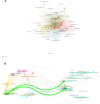A bibliometric insight into neoadjuvant chemotherapy in bladder cancer: trends, collaborations, and future avenues
- PMID: 38444854
- PMCID: PMC10912866
- DOI: 10.3389/fimmu.2024.1297542
A bibliometric insight into neoadjuvant chemotherapy in bladder cancer: trends, collaborations, and future avenues
Abstract
Background: Neoadjuvant chemotherapy (NAC) followed by radical cystectomy (RC) remains the cornerstone of treatment for muscle-invasive bladder cancer (MIBC). While platinum-based regimens have demonstrated benefits in tumor downstaging and improved long-term survival for selected patients, they may pose risks for those who are ineligible or unresponsive to chemotherapy.
Objective: We undertook a bibliometric analysis to elucidate the breadth of literature on NAC in bladder cancer, discern research trajectories, and underscore emerging avenues of investigation.
Methods: A systematic search of the Web of Science Core Collection (WoSCC) was conducted to identify articles pertaining to NAC in bladder cancer from 1999 to 2022. Advanced bibliometric tools, such as VOSviewer, CiteSpace, and SCImago Graphica, facilitated the examination and depicted the publication trends, geographic contributions, institutional affiliations, journal prominence, author collaborations, and salient keywords, emphasizing the top 25 citation bursts.
Results: Our analysis included 1836 publications spanning 1999 to 2022, indicating a growing trend in both annual publications and citations related to NAC in bladder cancer. The United States emerged as the predominant contributor in terms of publications, citations, and international collaborations. The University of Texas was the leading institution in publication output. "Urologic Oncology Seminars and Original Investigations" was the primary publishing journal, while "European Urology" boasted the highest impact factor. Shariat, Shahrokh F., and Grossman, H.B., were identified as the most prolific and co-cited authors, respectively. Keyword analysis revealed both frequency of occurrence and citation bursts, highlighting areas of concentrated study. Notably, the integration of immunochemotherapy is projected to experience substantial growth in forthcoming research.
Conclusions: Our bibliometric assessment provides a panoramic view of the research milieu surrounding neoadjuvant chemotherapy for bladder cancer, encapsulating the present state, evolving trends, and potential future directions, with a particular emphasis on the promise of immunochemotherapy.
Keywords: bibliometrics; bladder cancer; immune checkpoint inhibitors; neoadjuvant chemotherapy; platin-based.
Copyright © 2024 Huang, Liao, Shen, Zou, Xie, Gan, Yao, Zheng and Kong.
Conflict of interest statement
The authors declare that the research was conducted in the absence of any commercial or financial relationships that could be construed as a potential conflict of interest. The reviewer XD declared a shared parent affiliation with the authors YH, CL, YZ, WX, QG, YY, JZ and JK to the handling editor at the time of review.
Figures







Similar articles
-
Bibliometric insight into neoadjuvant immunotherapy in non-small cell lung cancer: trends, collaborations, and future avenues.Front Immunol. 2025 Feb 10;16:1533651. doi: 10.3389/fimmu.2025.1533651. eCollection 2025. Front Immunol. 2025. PMID: 39995679 Free PMC article.
-
The global research of bladder cancer immunotherapy from 2012 to 2021: A bibliometric analysis.Front Oncol. 2022 Nov 14;12:999203. doi: 10.3389/fonc.2022.999203. eCollection 2022. Front Oncol. 2022. PMID: 36452503 Free PMC article.
-
Prediction of future research trends in bladder urothelial carcinoma: Bibliometric analysis.Medicine (Baltimore). 2024 Feb 16;103(7):e37176. doi: 10.1097/MD.0000000000037176. Medicine (Baltimore). 2024. PMID: 38363885 Free PMC article.
-
Research Trends in the Application of Artificial Intelligence in Oncology: A Bibliometric and Network Visualization Study.Front Biosci (Landmark Ed). 2022 Aug 31;27(9):254. doi: 10.31083/j.fbl2709254. Front Biosci (Landmark Ed). 2022. PMID: 36224012
-
Immune regulation and the tumor microenvironment in anti-PD-1/PDL-1 and anti-CTLA-4 therapies for cancer immune evasion: A bibliometric analysis.Hum Vaccin Immunother. 2024 Dec 31;20(1):2318815. doi: 10.1080/21645515.2024.2318815. Epub 2024 Feb 28. Hum Vaccin Immunother. 2024. PMID: 38419524 Free PMC article. Review.
Cited by
-
Efficacy and safety of BCG and immune checkpoint inhibitors in non-muscle invasive bladder cancer: A meta-analysis with exploratory chemotherapy comparisons.Oncol Lett. 2025 May 16;30(1):348. doi: 10.3892/ol.2025.15094. eCollection 2025 Jul. Oncol Lett. 2025. PMID: 40438876 Free PMC article.
-
Global research trends and hotspots on imaging of bladder cancer: A bibliometric and visual analysis from 1981 to 2023.Medicine (Baltimore). 2025 Mar 21;104(12):e41907. doi: 10.1097/MD.0000000000041907. Medicine (Baltimore). 2025. PMID: 40128048 Free PMC article.
-
Global research hotspots and trends in the field of surgical treatment of congenital tracheal stenosis in infants and children over the past 40 years: A bibliometric and visualization study.Medicine (Baltimore). 2025 Jul 4;104(27):e43143. doi: 10.1097/MD.0000000000043143. Medicine (Baltimore). 2025. PMID: 40629600 Free PMC article.
-
Overexpressed KCNK1 regulates potassium channels affecting molecular mechanisms and biological pathways in bladder cancer.Eur J Med Res. 2024 Apr 30;29(1):257. doi: 10.1186/s40001-024-01844-1. Eur J Med Res. 2024. PMID: 38689322 Free PMC article.
-
Research trends of neoadjuvant therapy in lung cancer: a bibliometric analysis.Discov Oncol. 2025 Mar 15;16(1):321. doi: 10.1007/s12672-025-02011-6. Discov Oncol. 2025. PMID: 40088301 Free PMC article.
References
Publication types
MeSH terms
LinkOut - more resources
Full Text Sources
Medical
Research Materials

